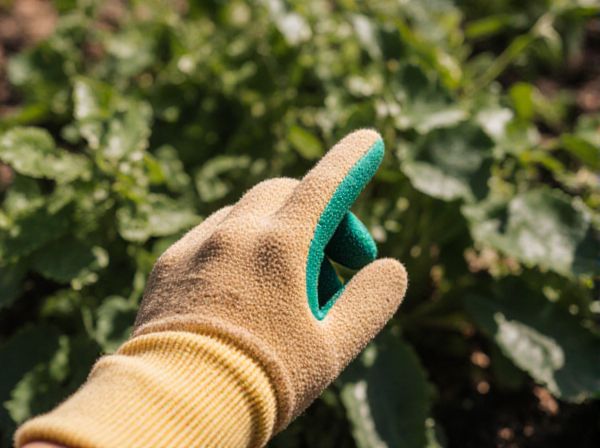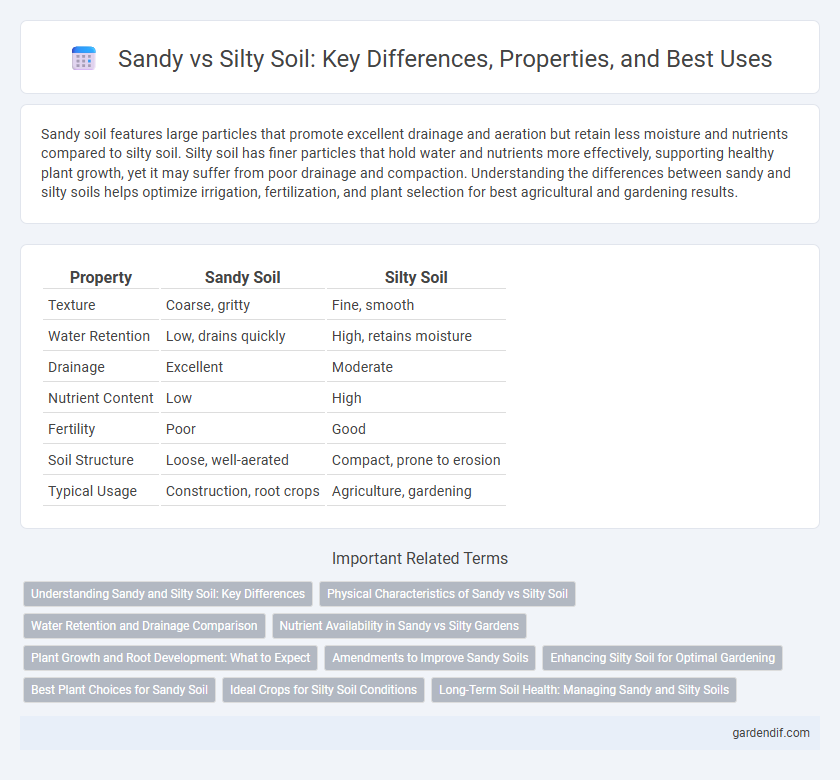
Sandy vs Silty Illustration
Sandy soil features large particles that promote excellent drainage and aeration but retain less moisture and nutrients compared to silty soil. Silty soil has finer particles that hold water and nutrients more effectively, supporting healthy plant growth, yet it may suffer from poor drainage and compaction. Understanding the differences between sandy and silty soils helps optimize irrigation, fertilization, and plant selection for best agricultural and gardening results.
Table of Comparison
| Property | Sandy Soil | Silty Soil |
|---|---|---|
| Texture | Coarse, gritty | Fine, smooth |
| Water Retention | Low, drains quickly | High, retains moisture |
| Drainage | Excellent | Moderate |
| Nutrient Content | Low | High |
| Fertility | Poor | Good |
| Soil Structure | Loose, well-aerated | Compact, prone to erosion |
| Typical Usage | Construction, root crops | Agriculture, gardening |
Understanding Sandy and Silty Soil: Key Differences
Sandy soil is characterized by large, coarse particles that promote excellent drainage but poor nutrient retention, making it ideal for plants that require well-aerated soil. Silty soil contains much finer particles, resulting in smoother texture and better water retention, which supports more nutrient availability and moisture for plant roots. Understanding these differences helps in selecting appropriate soil amendments and irrigation practices for optimal plant growth.
Physical Characteristics of Sandy vs Silty Soil
Sandy soil consists of larger particles, typically between 0.05 and 2 mm in diameter, resulting in high permeability and quick drainage, but poor water retention. Silty soil has finer particles ranging from 0.002 to 0.05 mm, providing smoother texture, greater nutrient retention, and improved moisture-holding capacity. The particle size distribution in sandy soil contributes to increased aeration and reduced compaction compared to the denser, more cohesive nature of silty soil.
Water Retention and Drainage Comparison
Sandy soil features large particles that promote excellent drainage but result in low water retention, making it prone to drying out quickly. Silty soil, composed of finer particles, exhibits moderate drainage while significantly enhancing water retention due to its ability to hold moisture effectively. Gardeners often prefer silty soil for crops needing consistent moisture, whereas sandy soil suits plants requiring well-aerated roots and rapid water runoff.
Nutrient Availability in Sandy vs Silty Gardens
Silty soils generally offer higher nutrient availability than sandy soils due to their finer particle size and greater surface area, which enhances nutrient retention and cation exchange capacity. Sandy soils drain quickly and have lower organic matter content, causing nutrients to leach rapidly and reducing their availability for plants. Gardeners working with sandy soil often need to supplement with organic matter and frequent fertilization to maintain adequate nutrient levels.
Plant Growth and Root Development: What to Expect
Sandy soil, characterized by large particles and excellent drainage, promotes rapid root penetration but often lacks nutrient retention essential for optimal plant growth. Silty soil, finer in texture with higher moisture and nutrient-holding capacity, supports robust root development and sustained nutrient uptake. Plants in silty environments typically exhibit stronger growth and resilience compared to those in sandy soils due to improved water availability and fertility.
Amendments to Improve Sandy Soils
Sandy soils benefit significantly from organic amendments such as compost, peat moss, and well-rotted manure to enhance water retention and nutrient-holding capacity. Incorporating biochar can improve soil structure and promote microbial activity, while applying mulch helps reduce moisture evaporation and temperature fluctuations. Regular addition of gypsum can also aid in improving soil aggregation and nutrient availability in sandy substrates.
Enhancing Silty Soil for Optimal Gardening
Enhancing silty soil for optimal gardening involves improving its drainage and nutrient retention by incorporating organic matter such as compost or well-rotted manure. Silty soil, characterized by its fine particles, holds moisture better than sandy soil but can become compacted, reducing oxygen availability to plant roots. Regularly amending silty soil with mulch and ensuring proper aeration promotes healthier root development and higher crop yields.
Best Plant Choices for Sandy Soil
Sandy soil drains quickly and tends to be low in nutrients, making it ideal for drought-tolerant plants such as lavender, rosemary, and succulents that thrive in well-aerated, fast-draining conditions. Root vegetables like carrots and radishes also perform well in loose, sandy soil due to ease of root expansion. Incorporating organic matter can improve moisture retention, supporting a wider range of plants adapted to sandy substrates.
Ideal Crops for Silty Soil Conditions
Silty soil, characterized by its fine particles and excellent moisture retention, is ideal for crops such as rice, wheat, and barley, which thrive in nutrient-rich and well-drained environments. Its smooth texture supports root development and nutrient absorption better than sandy soil, making it suitable for vegetables like lettuce, spinach, and carrots. Crops grown in silty soil generally exhibit higher yields due to the soil's capacity to retain essential nutrients and water efficiently.
Long-Term Soil Health: Managing Sandy and Silty Soils
Sandy soils, characterized by large particles and high drainage, require consistent organic matter additions to improve moisture retention and nutrient availability for long-term soil health. Silty soils, with finer particles and better nutrient-holding capacity, benefit from regular aeration and careful water management to prevent compaction and maintain structure. Effective management of both sandy and silty soils involves tailored strategies that enhance soil microbial activity and sustain fertility over time.
Sandy vs Silty Infographic

 gardendif.com
gardendif.com